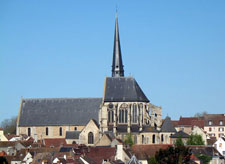Gallardon (Eure-et-Loir, France) - Saint-Pierre
- Disclaimer
The dating found here is based on the work of John James, and is meant on this site to serve as a starting point. James' dating is derived from a system that uses his interpretation of the development of capitals over time as the basis for chronology, among other factors. His goal is to refine the dating to within years rather than decades. I have not fully embraced James' methodology, and will be developing this page from its current state to one which is admittedly more conservative. The relative expenditure values found in the Timeline are also based on James' work, and I believe these to be reasonably reliable. They are intended only to give a sense of the amount of work involved in each decade.
I have added the idea of the "project" as a way of separating work in buildings. In my mind, a "project" is a discrete section of work in a building that resulted from the one-time acquisition of funding. "Projects" are generally separated by at least a decade where no work was being done. It is my view that it would have been unwise to start a "project" that could not be finished and protected from the elements, and as such a "project" usually involved a wing or multiple wings of a building, from floor to roof. Rural churches, which could only secure small amounts of funding at irregular intervals, often were the result of many small projects, while the great churches, which benefitted from relatively consistent funding, may have involved only a few large projects.
I have added the idea of the "project" as a way of separating work in buildings. In my mind, a "project" is a discrete section of work in a building that resulted from the one-time acquisition of funding. "Projects" are generally separated by at least a decade where no work was being done. It is my view that it would have been unwise to start a "project" that could not be finished and protected from the elements, and as such a "project" usually involved a wing or multiple wings of a building, from floor to roof. Rural churches, which could only secure small amounts of funding at irregular intervals, often were the result of many small projects, while the great churches, which benefitted from relatively consistent funding, may have involved only a few large projects.
- Timeline with Relative Expenditure (if available, in building units)
 |
 |
 |
 |
 |
 |
- Project A - 1070s - Phase 1 - nave
Nave and west wall, with dado arcade and caps, west door
- Project B - 1180s - Phase 2 - choir (a) I
Choir phase I; from the 1180s onwards new shafts, capitals and piers working in one slow campaign from north to south; the earlier choir lay within the piers, and was demolished leaving a smaller opening into the nave that was not replaced until the C15 with W1-w buttresses
- Project B - 1190s - Phase 3 - choir (a) II
Choir ambulatory phase II; three chapels to different plans, but cant tell the order; as3-en2, ne chapel; choir walls possibly without vaults
- Project B - 1200s - Phase 4 - choir (a) III
Choir aisles phase III; were cross arches over ambulatory and the groin vaults there as part of the earlier work, or were they with the new arcade as the new arcade may have underpinned the old.
- Project C - 1230s - Phase 5 - choir (t)
Choir triforium to clerestory sills
- Project C - 1240s - Phase 6 - choir (c)
Choir clerestory with tracery and flyers and vaults
